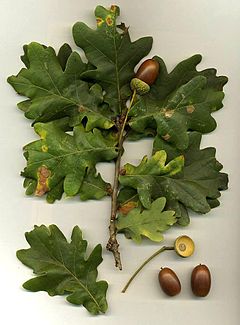Oak - Simple English Wikipedia, the free encyclopedia
| Oak (Quercus) | |
|---|---|
 | |
| Foliage and acorns of Quercus robur | |
| Scientific classification | |
| Kingdom: | |
| Phylum: | |
| Class: | |
| Order: | |
| Family: | |
| Genus: | Quercus |

The oak tree is a tree or shrub in the genus Quercus. There are about 500 living species. They are divided into subgenera. The common name "oak" may also appear in the names of species in related genera, such as Lithocarpus.[1]
Oaks have spirally arranged leaves, with rounded edges in many species; some have leaves with jagged edges or entire leaves with smooth margins. Many deciduous species do not drop dead leaves until the next Spring. In Spring, a single oak tree produces both male flowers (as catkins) and small female flowers.[2] The fruit is a nut called an acorn, carried in a cup-like structure. Each acorn has one seed (rarely two or three) and takes 6–18 months to mature, depending on species. The so-called "live oaks" are evergreen. They are not a taxonomic group, just a life style which occurs in the genus.
The oak is a kind of hardwood forest tree. They are well known as a climax vegetation in the temperate zone of the northern hemisphere. That means, left untouched by humans, it would be the dominant tree. Much of England was covered by oak forests before modern farming took over the land. The last extensive oak woodlands were cut down to build ships for the Royal Navy in the 18th century.
Some kinds of oak wood are very hard. That is why people in past centuries cut them down to make ships, furniture and other things. The wood is now scarce and expensive and only used to make a few things anymore. Much cheaper are softwoods like pine.
Oak trees grow slowly and can live up to 1000 years.
Associated animals
[change | change source]A mature oak tree stands about 100 feet tall (~30 metres). It is a home for more animals than any other European tree.[3] 30 species of birds, 45 different bugs and over 200 species of moth have been found on oaks. Beetles burrow under the bark, and some drill holes into the wood. The leaves are eaten by many caterpillars. Many leaves carry strange little bumps on the underside. These are insect galls, caused by many little animals. Midges, moths, worms and tiny wasps lay their eggs in leaves or leaf buds. The leaf reacts by forming a growth around the eggs. Inside the gall, larvae develop. The leaf falls, but the larvae may come out only the next spring. Small galls only have one larva, but larger galls may contain as many as 30 larvae.[3]
Acorns
[change | change source]Oak trees produce acorns once a year which ripen in autumn. Oak trees may start producing acorns when they are about 20 years old. A mature oak may produce 90,000 acorns a year; this is several millions in its lifetime.[3]
Related pages
[change | change source]References
[change | change source]- ↑ Hogan, C. Michael 2012. Oak. ed. Arthur Dawson. Encyclopedia of Earth. National Council for Science and the Environment. Washington DC
- ↑ Conrad, Jim. 2011. "Oak flowers". backyardnature.com.
- ↑ 3.0 3.1 3.2 Attenborough, David 1995. The private life of plants. London: BBC Books, 152–158. ISBN 0-563-37023-8


 French
French Deutsch
Deutsch